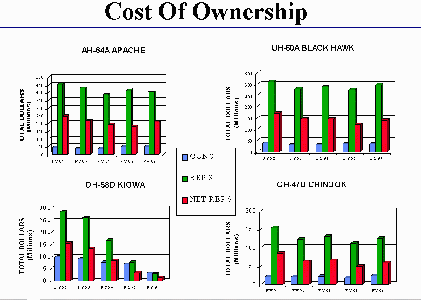


Rotary Aircraft
Aviation combat missions are performed by maneuver forces engaged in shaping the battlespace and conducting decisive combat operations by employing direct fire and standoff precision weapons in combined arms operations.
Reconnaissance operations obtain information by visual observation or other detection methods. This information may concern the activities and resources of an enemy or potential threat, or the meteorological, hydrographic characteristics of a particular area. Reconnaissance assets must possess the ability to develop the situation, process the information, and provide it to commanders in near real time. Army aviation's most modern assets, the OH-58D Kiowa Warrior and the AH-64 Apache, give the force commander a dramatically improved 24-hour air reconnaissance capability.
The primary purpose of attack helicopter operations is the destruction of enemy ground force at decisive points. Attack units can conduct deep operations or be used in conjunction with ground maneuver units during close battle operations. For cross-component support, Army attack
helicopters, usually tasked as units, can perform a close air support (CAS) function. Attack units normally are most effective when used in mass in continuous operations on the enemy's flanks and rear. Night operations are the preference.
Although the primary mission of an attack helicopter is to destroy armored and mechanized threat targets, this mission changes when the helicopter is employed in a low-intensity conflict (LIC). In this environment, it may assume a role similar to close air support (CAS) for the units on the ground. With this new role, it is important for infantry units to effectively communicate with and direct the attack aircraft. Small infantry units can already call in fire from attack helicopters; this was very common in many combat actions in Vietnam. But the art of providing attack helicopter fire support to light infantry has been lost, for the most part, from disuse. The reason is that although attack helicopters can be used throughout the spectrum of conflict from low- to high-intensity, the focus has been on mid- to high-intensity where they can mass fires against armor and mechanized forces. There are many ways the attack helicopter can be tasked to support an infantry unit, whether it is requested on the spot, through battalion and brigade, or assigned a direct support role during a mission. No matter how the tasking comes down, communication between the helicopter and the ground unit is paramount.
Air assault operations are those in which air assault forces employing the firepower, mobility, protection, and total integration of helicopter assets in their air or ground roles maneuver on the battlefield, under the control of the air assault task force commander (AATFC), to engage and destroy forces or to seize and hold key terrain. Air assault operations are inherently complex, fully synchronized combat operations particularly important for light forces as they are the primary means of rapid deployment.
Utility and cargo helicopters operate throughout the battlefield. As a fully integrated member of the combined arms team, utility and cargo helicopter units conduct combat, combat support and combat service support operations in support of the commander. They operate throughout the battlefield framework and are capable of conducting operations day and night.
Army operations require worldwide strategic mobility. Given this requirement, utility and cargo helicopter units must be able to conduct operations in multiple environments. These operations range from war to stability and support operations. Army aviation doctrine focuses on the integration and synchronization of helicopters as a member of the combined arms team. The
ability to successfully conduct operations depends on the correct application of the five basic tenets of Army doctrine. These tenets include initiative, agility, depth, synchronization, and versatility.
Doctrinal Development
The original function of organic Army aviation during World War II was to assist in the adjustment of artillery fire. During the course of the war, however, organic aviation's small fixed-wing aircraft, commonly known as Grasshoppers, came to be used for command and control (C2), medical
evacuation (MEDEVAC), wire laying, courier service, aerial photography, reconnaissance, and other purposes. The principal reason for the expanding mission of organic Army aviation was that its aircraft were accessible to ground commanders and able to operate in close coordination with ground forces. The aircraft of the Army Air Forces often were not.
Both the original creation of organic Army aviation and its assumption of additional functions during World War II provoked friction and rivalry between the Army Ground Forces and the Army Air Forces. When the Army Air Forces became the US Air Force in 1947 and organic Army aviation
remained part of the Army, the friction continued and lasted until the 1970s. To avoid the expense of having two aviation organizations with overlapping functions, the War Department and later the Department of Defense (DOD) established restrictions on the roles and missions of Army aviation and
on the size and type of Army aircraft. These restrictions
were specified in a series of War Department and DOD memoranda and by agreements between the Army and the Air Force that began in 1942 and continued until 1975.
The United States Army Aviation Center (USAAVNC) was established at Fort Rucker in 1955, and in 1956, the Aviation School began mounting weapons on helicopters and developing air cavalry tactics. The Aviation School technically was not in total conformity with DOD restrictions on the Army's use of aircraft.
The Johnson-McConnell Agreement of 6 April 1966 authorized the Army to develop and employ rotary-wing aircraft for all intratheater purposes, including troop movement and fire support. In return, Army aviation gave up its larger fixed-wing aircraft and became, more so than ever, a rotary-wing force. From 1966 to the present, the Army has been the recognized American leader in the development of helicopters and helicopter weapons, tactics, and doctrine.
The Army continued to desire fixed-wing CAS from the Air Force. It was, therefore, relatively easy for the two services to agree, in 1975, that the attack helicopter did not perform CAS. Instead, it was an extension of organic firepower, and the Air Force would continue to provide CAS with fixed-wing aircraft. Since that time, there have been no serious disagreements over aviation missions and functions between the Army and the Air Force.
Operational Employment
Although Army aviation has continued to use some fixed-wing aircraft up to the present, its evolution to its current role and status resulted to a large degree from the development of the helicopter and of rotary-wing tactics and doctrine. The war in Korea clearly demonstrated the potential of the helicopter, especially for MEDEVAC and tactical transportation. Although the Army was not able or prepared to employ helicopters for other missions during that period, the Marine Corps successfully demonstrated the helicopter's value in "vertical envelopment" operations--an early version of air mobility and air assault.
Helicopters were first used to transport Vietnamese troops in January 1962. They played an ever-growing role in the conflict in Southeast Asia from that time until the American withdrawal. In 1965, the first air mobile division, the 1st Cavalry Division (Airmobile), was organized and sent to
Vietnam. With the arrival of the UH-1 (Huey), other turbine-powered aircraft, and two airmobile Army divisions, helicopter warfare became the most important innovation of the conflict. The armed helicopter in the tactical role of fire support to the infantry was developed and perfected. Armed helicopters became essential for providing direct fire support to units operating outside the range of their direct support artillery.
Army aviation units were involved in all major contingency operations during the 1980s and 1990s. In Operation Urgent Fury, the American invasion of Grenada in October 1983, both the Marine Corps and the Army used helicopters. For the Army, Urgent Fury was the first combat test of the new UH-60 Black Hawks, which were used for assault, MEDEVAC, and transport during the operation. Three Army aviation battalions took part in Operation Urgent Fury.
Another new Army helicopter, the OH-58D Kiowa Warrior, was employed in the Persian Gulf in 1987. The Army armed 15 of these aircraft with Hellfire missiles and stationed them on U.S. Navy ships in the Persian Gulf to protect shipping during the war between Iran and Iraq.
Approximately 160 Army helicopters took part in Operation Just Cause, the American invasion of Panama beginning in December 1989. AH-64 Apaches self-deployed from the United States and engaged in combat for the first time. Other Army aircraft performing attack, assault, transportation, and
observation roles in Operation Just Cause included Cobras, Black Hawks, Chinooks, Kiowas, and Hueys. The invasion of Panama employed the largest number of special operations aircraft (65 helicopters and 20 fixed-wing planes) ever employed by United States forces. There was general
agreement that special operations air support was the best that had ever been provided. Although the Apache exhibited some mechanical problems during Just Cause, it performed well as an advanced attack aircraft. Operation Just Cause enabled Army aviators to demonstrate in combat that, through the use of the night vision devices with which they had trained, they could "own the night."
In the early morning of 17 January 1991, an Army aviator fired the first shot of Operation Desert Storm from an Army helicopter. Within a few minutes, two teams of Apaches totally destroyed two Iraqi radar stations, paving way for the air war over Iraq to be conducted with relative impunity.
During the 100-hour ground war, which began about a month later, Army attack helicopters played their most decisive role ever in combat. Whatever doubts remained regarding its durability and combat effectiveness were quickly dispelled. Dozens of aviation units and several hundred helicopters of all types took part in the Gulf War. In addition to attack, helicopters were used for air assault, reconnaissance, transportation, combat search and rescue, and observation. Operation Desert Storm was the first major military operation conducted on a largely electronic battlefield. Army aviation amply demonstrated its effectiveness in this environment and also proved again that it could own the night by carrying out many of its combat operations during
darkness.
Since Desert Storm, Army aviation has taken part in several other operations: Provide Comfort in northern Iraq, Restore/Continue Hope in Somalia, Uphold Democracy in Haiti, and the NATO operation in Bosnia.
Naval Helicopter Operations
Shipboard or overwater specified tasks are found in nearly all regional contingency plans, JTF plans, and
counternarcotics operations. Shipboard missions require deck landings and support operations
performed from a ship. Overwater missions include operations over open water but originate and/or end
at a land base.

Sources and Resources
http://www.fas.org/man/dod-101/sys/ac/rotary.htm
Maintained by Robert Sherman
Originally created by John Pike
Updated Saturday, October 16, 1999 10:34:12 AM




